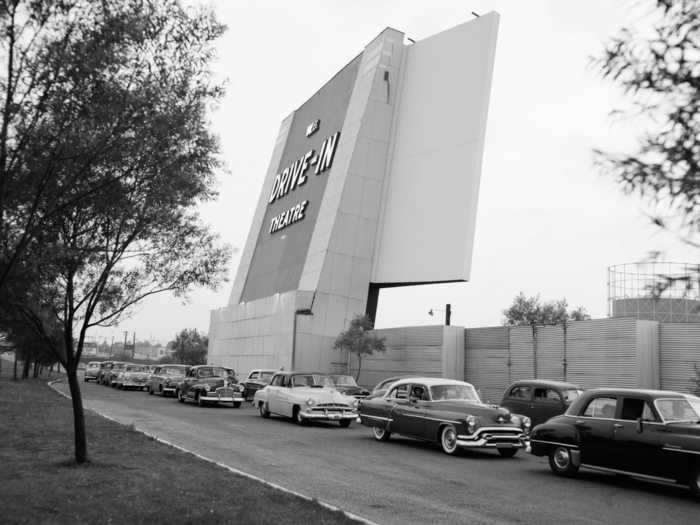
A drive-in movie in 1948 (left) and in 2020.Allan Grant/The LIFE Picture Collection via Getty Images, MEHDI FEDOUACH/AFP via Getty Images
There used to be thousands of drive-in movie theaters across the US. Now, according to the United Drive-in Theatre Owners Association, there are only 305 still in operation. But in 2020, business is booming.
A fixture of the 1950s and '60s, drive-in movies have made a comeback during the coronavirus pandemic. Since outdoor spaces are generally less risky, and each group can remain in their own car, drive-in movies have been allowed to open while traditional indoor theaters are still shuttered.
Many aspects of the drive-in experience have changed since they first became popular decades ago. Here's how drive-in movies have changed over the years.
Read the original article on Insider
After Hollingshead's mother complained about uncomfortable theater seats, he came up with the idea for a cozier movie-watching experience. He opened his first drive-in theater in 1933.

The coronavirus is primarily spread through person-to-person contact, putting large gatherings in places like traditional movie theaters on hold. But at drive-in theaters, it's easier to practice social distancing.

The outdoor theaters operated rain or shine.

New York Governor Andrew Cuomo allowed drive-ins and other "low-risk" outdoor businesses to reopen on May 15 during the COVID-19 outbreak. The Warwick Drive-In in Warwick, New York, is operating at half its capacity to allow for social distancing between cars.

Hollingshead showed a British comedy called "Wives Beware" at the first drive-in.

There are often discounts for children and seniors, or a flat price per car. The prices are lower than regular movie tickets, adding to the appeal even before the pandemic.

Carhops served trays of food and drinks to guests in their cars.

Face coverings help slow the spread of the virus.

The All-Weather Drive-In in Copiague, New York, was one of the largest drive-in theaters. In addition to 2,500 parking spots, it also featured a playground for kids and a full-service restaurant, according to History.com.

Signs remind movie-goers that face masks and social distancing practices are required.

It's much easier to steal a kiss in a car than in a crowded movie theater.

Coming up with safe date ideas during the pandemic can be challenging.

They were a popular family-friendly activity.

With drive-in theaters operating at 50% capacity to allow for social distancing, the view of the screen is even better.

There are now only 305 drive-in theaters left in the US.

It's also possible that some movie theaters won't survive the financial losses incurred during lockdown.
 2 states where home prices are falling because there are too many houses and not enough buyers
2 states where home prices are falling because there are too many houses and not enough buyers US buys 81 Soviet-era combat aircraft from Russia's ally costing on average less than $20,000 each, report says
US buys 81 Soviet-era combat aircraft from Russia's ally costing on average less than $20,000 each, report says A couple accidentally shipped their cat in an Amazon return package. It arrived safely 6 days later, hundreds of miles away.
A couple accidentally shipped their cat in an Amazon return package. It arrived safely 6 days later, hundreds of miles away. 9 health benefits of drinking sugarcane juice in summer
9 health benefits of drinking sugarcane juice in summer
 10 benefits of incorporating almond oil into your daily diet
10 benefits of incorporating almond oil into your daily diet
 From heart health to detoxification: 10 reasons to eat beetroot
From heart health to detoxification: 10 reasons to eat beetroot

Copyright © 2024. Times Internet Limited. All rights reserved.For reprint rights. Times Syndication Service.